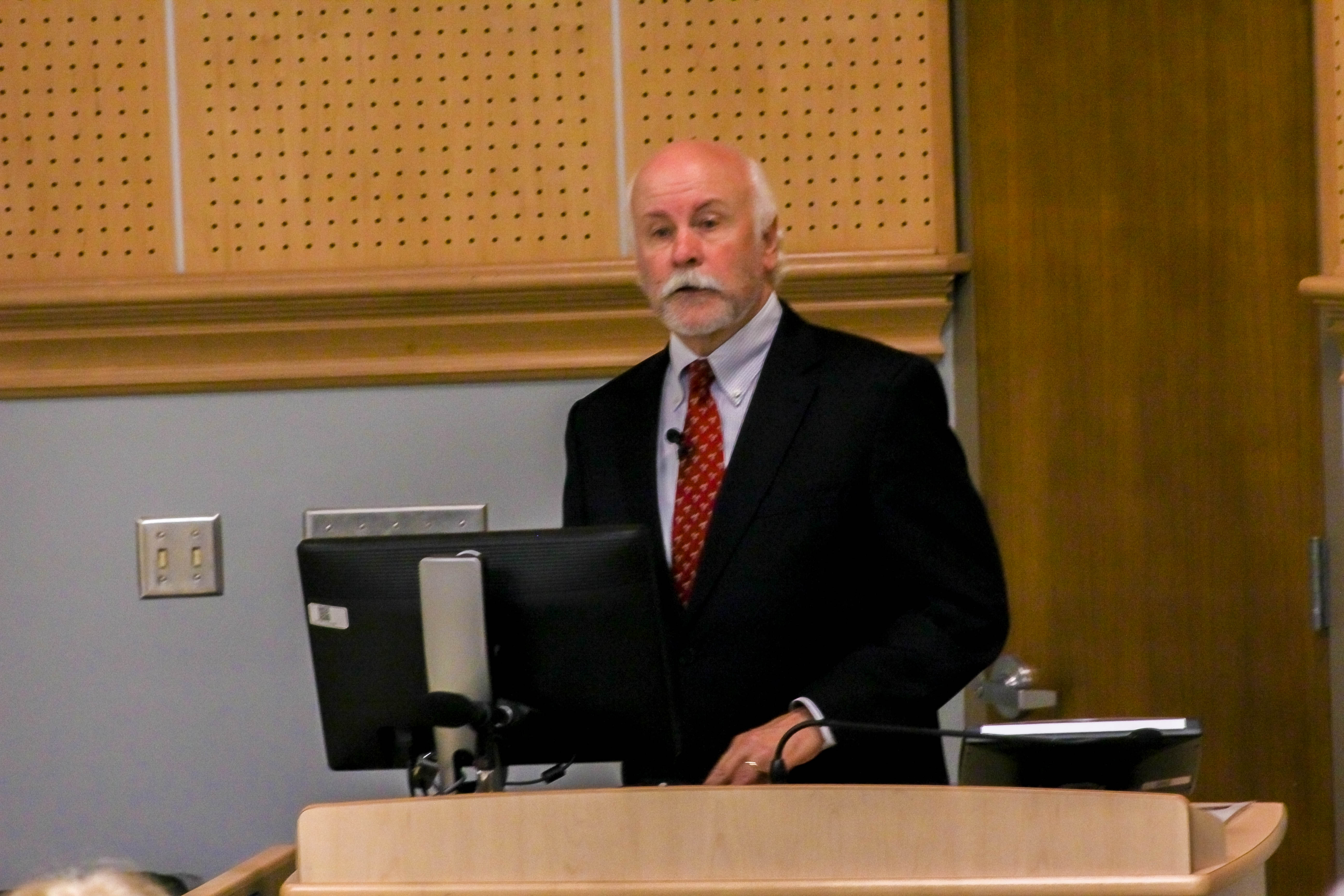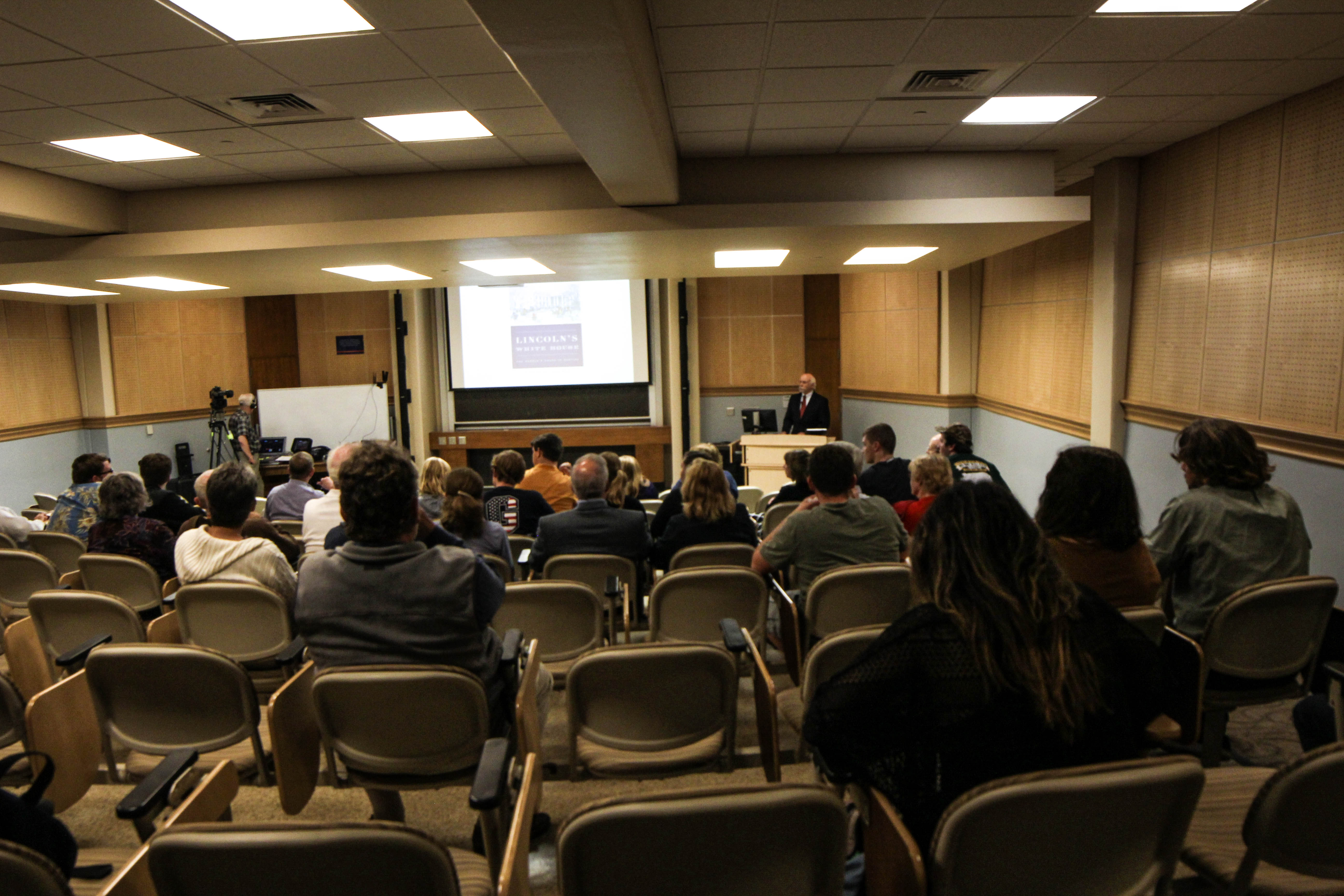
James Conroy speaks at the Gilder-Lehrman lecture in Bowen Auditorium
Photo Claire Bickers / The Gettysburgian
By Sarah Kirkpatrick, Staff Writer
Gettysburg College’s Civil War Institute sponsored a lecture Thursday by James Conroy, a recipient of the 2017 Gilder Lehrman Lincoln Prize, about his winning book Lincoln’s White House: The People’s House in Wartime. The Gilder Lehrman Institution and Gettysburg College award this prize annually to an outstanding historical work on Abraham Lincoln or the Civil War soldier. This is Conroy’s second book about Lincoln, but his first to be awarded this honor.
“I don’t think of Lincoln’s White House as an especially profound contribution to Civil War scholarship as opposed to what I hope is an interesting and occasionally insightful behind-the-scenes look at the White House itself, its professional staff, its servants, its open door policy…, its security, and its day-to-day life,” explains Conroy.
Conroy’s interest in Lincoln began at the age of 12 during the Civil War Centennial when he read The Day Lincoln was Shot by Jim Bishop and began to entertain the idea of writing his own book about the president.
“Several turns in the road brought me to law school instead of graduate school, but I never abandoned the ambition to write history, my first love,” he explains. “Now that I am semi-retired from the law and no longer need it to make a living, I have had the time and the opportunity to pursue that goal, and the good fortune to reach it.”
Through his work, Conroy pieces together contemporary photographs, engravings, and diary entries to present his readers with a vision of the White House that is familiar, yet strange. Although certain features of the building have remained the same, its elegant character is a more recent addition.
When the Lincolns arrived at the White House, it was less than luxurious. Contemporaries compared the American icon to a mediocre hotel, describing it as hot, humid, and foul-smelling. Similarly, Washington, D.C. was largely underdeveloped at the time, consisting exclusively of buildings under two stories and with only one paved street to speak of: Pennsylvania Avenue.
Shortly after moving in, Mary Todd undertook the task of renovating the building. She quickly exceeded her $20,000 budget to purchase ornate furniture, china, and other décor.
Another stark difference between Lincoln’s White House and its modern equivalent was its security. Lincoln endorsed an open door policy throughout his presidency, even during wartime, so his entire security force consisted of a few young guards who allowed visitors to enter freely.
People wandered through the hallways in hopes of meeting celebrities or speaking to Lincoln himself, and as soon as Lincoln appeared, he was besieged by office seekers and spectators who wanted his attention. To appease the common people, Lincoln even held weekly receptions to greet the public, shaking between 500 and 1,000 hands in an hour.
However, Lincoln’s lenient security policy caused problems when the Civil War began. Only a few troops were stationed in the capital, which was surrounded by hostile forces, so Lincoln put on a show of power until reinforcements arrived. According to Conroy, if Confederate troops had realized he was bluffing and attacked D.C. at this time, the war may have ended with their victory.
Conroy also explored Lincoln’s personality and interpersonal relationships to try to reconstruct what it would have been like to live and work in his White House. As a father, Lincoln was a poor disciplinarian, letting his youngest son Tad interrupt Cabinet meetings and bother the troops stationed on the White House lawn. Professionally, Lincoln was well-liked by his staff, but gained a reputation for being inept at small talk. This made it difficult for him to employ personal diplomacy in international affairs, but he relied on trusted cabinet member William Seward to handle these dealings for him.
Lincoln had a number of interactions with the celebrities and public figures who came through the White House as well, including Nathaniel Hawthorne, Ralph Waldo Emerson, and Frederick Douglass. Lincoln’s amiable relationship with Douglass was notable for its time, since their three meetings represented the first time a president invited a black leader to the White House to discuss major policy issues.
In addition, Conroy shared a number of surprising anecdotes about the president, including the fact that he once participated in a séance in the White House and often greeted well-dressed foreign dignitaries in his slippers. Mr. Conroy concluded the lecture by assessing the impact of Lincoln’s assassination on the country, claiming that it left Americans staggering, the recent and brutal war compounded by this sudden loss. Finally, he concluded the event with a Question and Answer session and a book signing.
After writing two pieces on Lincoln, Conroy is currently working on a book about Thomas Jefferson’s White House, which he considers “a sort of prequel, if you will, about a very different president in a very different time.”


September 12, 2017
I thoroughly enjoyed reading Sarah’s review of Mr.. James Conroy’s lecture regarding his book “Lincoln’s White House: The People’s Hiuse in Wartime” Her summary of both was very informative and well written.
After reading Sarah’s review, it peaked my interest in reading Mr. Conroy’s book.
Well done Sarah Kirkpatrick 👍🏻